Miami Arts: An Insider’s Perspective
Craig Robins on Miami's Growing Cultural Core
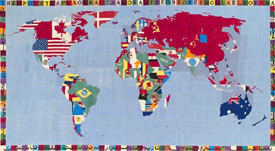
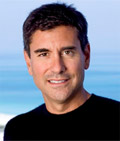
Anthony Japour (AJ) is an independent curator, private art dealer and owner of AJ Japour Gallery. The gallery deals in contemporary art with a focus on the Chinese Contemporary Art Movement and its relationship to the pillars of Western Contemporary Art. Since 2003, AJ has produced numerous art exhibitions and installations in Miami and South Florida. In addition, the Gallery’s secondary mission is to support organizations dedicated to the health, education, and welfare of children. AJ has served on the Fine Arts Board and the Cultural Arts Council of the City of Miami Beach.
It is often said in art circles that the first truly innovative works of art emanating out the United States were Abstract Expressionism circa 1940-50’s. However, it occurred to me during 2010 Art Basel Miami Beach (ABMB) that our first contribution to the contemporary art world occurred over two centuries before with an idea enshrined in our US Constitution, namely, freedom of expression.

ART = FREEDOM
2010 ART BASEL MIAMI BEACH ART FAIR
Look out New York and Sao Paulo, ABMB, in its ninth edition, is now the most prestigious art show in the Americas! I often hear people say “I can’t afford anything at ABMB.” What may surprise you is that you can find art works that are in the hundreds, rather than thousands, or millions of dollars.
With more than 200 galleries represented, here are a few artists from the fair who are well-known in their own countries, but perhaps less so in the United States:
Alighiero e Boetti
Sperone Westwater
257 Bowery
New York 10002
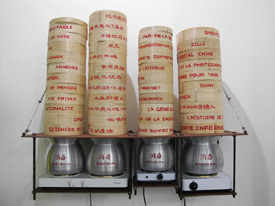
In 1968 the Italian artist Alighiero Boetti changed his name to Alighiero e [meaning “and”] Boetti, to highlight Boetti and undermine the idea of the artist as a unique individual.
In the early 1970’s Boetti began to travel to Afghanistan to employ Afghani weavers, to complete maps, rugs and inscriptions of his design, which some curators have compared to Sol LeWitt’s method of wall drawings. Other embroidered works include a series of world maps that he produced from 1970 through the late 1980s, of which the exhibition has one from 1989. Sperone Westwater is exhibiting one of these maps, which is approximately 4’ x 7’; the tapestry fills in the areas of continents with national flags, a representation that emphasizes the impermanence of a land’s identity and the real-life fragility of global politics. Boetti viewed the maps as a fulfillment of his artistic goals.
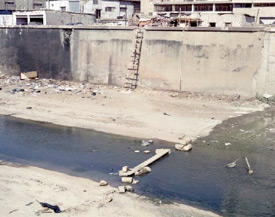
“To my mind, the work of the embroidered maps represents supreme beauty,” he said. “For these works, I made nothing, selected nothing, in the sense that the world is the way it is and I have not drawn it; the flags are those that exist anyway. Once the basic idea is there, the concept, then everything else is chosen.”
His words should be the anthem for all artists living and working in the contemporary art world.
Chen Zhen (1955-2000) was born in Shanghai and brought together memories of his childhood with iconic symbols of contemporary Chinese society to create a yin/yang dialogue on East and West, traditional and contemporary culture, communism and capitalism, and illness and health.
Growing up during the Cultural Revolution had a profound effect on him and his art works, which were produced during the reforms in China leading to the co-existance of communism and capitalism. Following his move to Paris in 1986 to attend the Ecole Nationale Suprieure des Beaux-Arts and the Institut des Hautes Etudes en Arts Plastiques, he began to move exclusively into installation art works. His work focuses on the relations between human beings, nature and objects; the incommunicability and lack of understanding between human beings; and finally on meditation and therapy. Before globalization, Chen sought a way to bridge the gap between Eastern and Western medicine, and using the human body, illness and medicine as metaphors for the mind-body and body-spirit in contemplative settings.
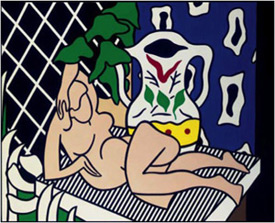
Walid Raad
Paula Cooper Gallery
534 West 21st Street
New York, New York 10011
Born in 1967 in Chbanieh, Lebanon, Walid Raad grew up during the conflicts in war-torn Lebanon. His way of coping with the trauma was to create a fantasy world for himself. Now, one of the most important contemporary artists coming out of the Middle East, Raad playfully considers the effects of conflict not only on the body and mind but also on art itself. He works in video, photography and literary essays. Raad, a professor at the Cooper Union School of Art has been exhibited at Documenta, which occurs once every five years and were considered among the most important exhibitions of modern and contemporary works of art. His monumental series, The Atlas Group (1989-2004) is his best-known work to date. His current work includes A History of the Arab World.
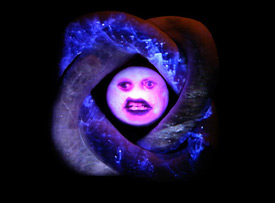
Karina Peisajovich
Alejandra von Hartz Gallery
2630 NW 2nd Avenue
Miami, Fl 33127
Born in Bueos Aires, Argentina in 1966, Peisajovich follows in the tradition of geometric abstraction of the avant-garde movement in South America with the use of light to produce her works of art. Her recent projects have moved from complex installations involving abstract forms painted from the gallery walls onto floors with geometric forms projected in light and shadows, to a more reduced set of elements: small light machines projecting colored light, placed within darkened spaces.
2010 Art Miami, Wynwood
2010 Art Asia
2010 Miami-Miami Beach Sculpture Biennial, Downtown Miami
As Miami’s longest running contemporary Art Fair, Art Miami continues into the direction of established modern and contemporary artists.
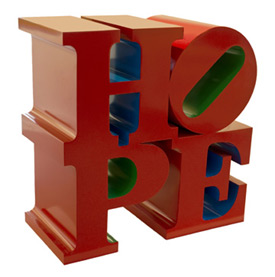
Roy Lichtenstein
Robert Indiana
Tony Oursler
Scott White Contemporary Art
939 West Kalmia Street
San Diego, CA 92101
Scott White Contemporary Art was a standout in terms of curatorial design and layout of its booth with an eye-pleasing combination of works, a pair of oil paintings by Roy Lichtenstein, a Robert Indiana “Hope” sculpture, and a mixed media work by Tony Oursler that was beautifully installed.
Qin Feng
Ethan Cohen Fine Arts
8 Jay Street
New York, New York 10013
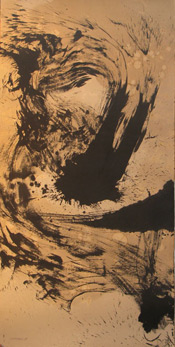
Born in Xinjiang, China in 1961, Qin Feng graduated from the Shandong Art Institute in 1985. Qin paints in the grand tradition of calligraphy with an infusion of abstract expressionism. He divides his time between Boston, where he is an artist-in-residence at the Museum of Fine Arts (MFA) and Beijing, where he is the founder of the Beijing Museum of Contemporary Art. In 2007, Qin’s work was selected and exhibited at the Metropolitan Museum of Art’s Brush and Ink exhibition: The Chinese Art of Writing. Currently on view in Boston’s Museum of Fine Arts exhibition, Fresh Ink: Ten Takes on Chinese Tradition.
Li Jikai
Dialogue Space Gallery
No. 32 Baiziwan Road, Chaoyang District
Beijing, China 100022
Born in Chengdu, China in 1975, Li graduated from the Sichuan Academy of Fine Arts in 2004 and was exhibited in Seoul Korea by Arario Gallery. His dream-like paintings, colorful and playful were on view by the Dialogue Space Gallery from Beijing.
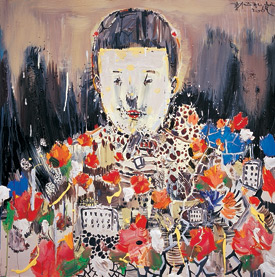
Joining Art Miami in Wynwood is Miami’s first Biennial for Sculpture. The exhibition is firmly planted downtown along Biscayne Boulevard stretching from the cultural arts center at the Adrienne Arsht Center and the site of the new Miami Art Museum to the Miami River at the Intercontinental Hotel.
The Biennial is the brainchild of gallery owner Gary Nader who worked with Miami Mayor Tomas Regalado, Commissioner Marc Sarnoff and many city officials to host the first-ever sculpture Biennial for Miami. With its opening on December 2nd and continuing through January 15 Miamians and our visitors will be able to view the works of some 50+ internationally-recognized sculptors chosen by the Biennial’s curator, Ricardo Pau-Llosa, including Fernando Botero (Colombia), Sando Chia (Italy), Daniel Escardo (Uruguay), Olafur Eliasson (Denmark), Keith Haring (USA), Martin Kippenberger (Germany), Roy Lichtenstein (USA), Enrique Martinez-Celaya (USA), Henry Richardson (USA), Henry Moore (UK), Carolina Sardi (Argentina), Frank Stella (USA), and Bernar Venet (France), among others.
45 Snails
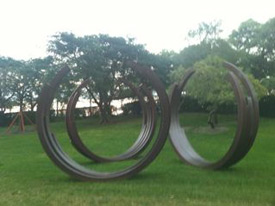
Made of recycled plastic, the 45 Snail Art Project is meant to teach us about our fast-paced lives. According to the gallery owner Gloria Porcella from Rome: “We run, run, run but what are we reaching? What are our goals? We are destroying our planet.’
The snail was chosen as a form because it carries its shelter on its back, shaped like an ear urging people to listen, as well as shaped like the @ symbol seen in email addresses – the Italians call the @ sign a snail. Sometimes public art projects work, and other times they don’t. In this case, unfortunately, it’s a dud. For an American living in Miami the snail represents traffic moving at a snail’s pace, governmental agencies that move at a snail’s pace, and one really has to ask how much oil was consumed in getting these gargantuan works from Rome to the United States.

On a brighter note, the color selected – pink – is reminiscent of Christo & Jeanne Claude’s 1980-83 work entitled “Surrounded Islands” where 11 of Biscayne Bay’s islands, situated in the areas of Baker’s Haulover, Broad Causeway, 79th Street Causeway, Julia Tuttle Causeway, and Venetian Causeway, were surrounded with 585,000 square meters (6.5 million square feet) of pink woven polypropylene fabric covering the surface of the water, floating and extending out 61 meters (200 feet) from each island into the Bay. The fabric was sewn into 79 patterns to follow the contours of the 11 islands. It remains the most important public art project in Miami’s history.
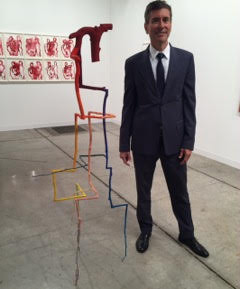
Anthony Japour is an art collector and art advisor. Japour lectures on the Chinese Contemporary Art Movement and its relationship to the pillars of Western Contemporary Art. For over a decade [2002-2012], Japour mounted numerous art exhibitions and installations in Miami Beach and South Florida through AJ Japour Gallery and linked these exhibitions to charity events at his home in South Beach devoted to the health, education and welfare of children. Japour has served on the Fine Arts Board and the Cultural Arts Council of the City of Miami Beach. Japour has been a contributor writing on contemporary art for SocialMiami.com since 2010.


